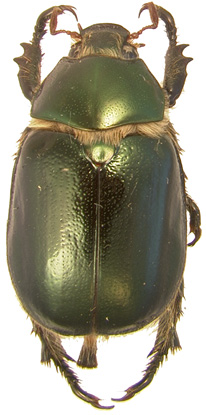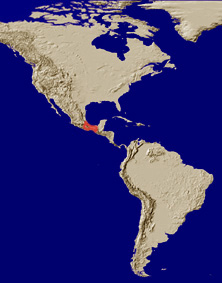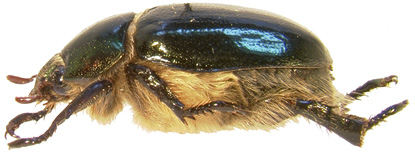 |
|||||||
|
|||||||
Viridimicus Jameson, 1990
Viridmicus aurescens
photo by Matthew R. Moore
distribution of Viridimicus species
Viridmicus aurescens
photo by Matthew R. Moore
|
||
| Rutelinae Taxa Map | ||
| Rutelini Taxa Map | ||
| Rutelinae Key | ||
| Rutelini Key | ||
| Areodina Key | ||
| Areodina Gallery |
Diagnosis: Viridimicus is distinguished from the other Rutelinae and Areodina by the following combination of characters: (1) clypeus semicircular, diverging slightly from the base and widest at the middle or clypeus sinuate laterally and converging apically toward a parabolic apex, (2) mentum notched apically, (3) apex of the parameres rounded, and (4) metallic green coloration of the male (Jameson 1990; Jameson 1999).
Taxonomy: The genus Viridimicus was established to accommodate species previously referred to as Cotalpa and Parabyrsopolis. The type species of this genus, V. aurescens, was originally described by Bates (1888) in the genus Byrsopolis and was previously placed in Cotalpa (Blackwelder 1944) and Parabyrsopolis (Ohaus 1918, 1934; Machatschke 1972).
Distribution: Viridimicus occurs from the Transverse Volcanic Belt in Mexico from near Mexico City, Mexico, to Honduras. Individuals are found in pine-oak forests at elevations from 1,700 to 2,300 m (Jameson 1990; Jameson 1999).
Revision or Synopsis:
Jameson, Mary Liz. 1990. Revision, phylogeny and biogeography of the genera Parabyrsopolis Ohaus and Viridimicus, new genus (Coleoptera: Scarabaeidae: Rutelinae). Coleopterists Bulletin 44(4): 377-422.
Composition: The genus Viridimicus contains seven species: V. aurescens (Bates, 1888); V. cyanochlorus Jameson, 1990; V. impunctatus Jameson, 1990; V. nigroaeneus (Bates, 1888); V. omoaensis Jameson, 1999; V. ratcliffei Jameson, 1990; V. unitus Jameson, 1990.
Biogeography (from Jameson 1990; Jameson 1999): Climatic fluctuations during the Late Cenozoic caused the expansion and constriction of forests across the range of Viridimicus. Species of Viridimicus underwent speciation in the relatively discontinuous mountain ranges to the south of the Transverse Volcanic Belt: V. ratcliffei in the southernmost extent of the Sierra Madre Oriental; V. cyanochlorus and V. impunctatus in the Sierra Madre del Sur (separated by the Rio Balsas depression); V. aurescens in the Sierra Madre de Chiapas, Chiapas Central Massif, and the Central American Nucleus; V. nigroaeneus in the Central American Nucleus; and V. omoaensis in the Sierra de Omoa.
The dispersal of Viridimicus southwards into Central America was prevented by two factors. First, the Isthmus of Panama served as a filter bridge for tropical and subtropical organisms after its rise in the Pliocene due to its more arid habitat. Second, the southern limit of pine-oak forest is the Nicaraguan Depression, just south of the Central American Nucleus. This low, arid region was a barrier for animals as well as plants such as Pinus (Pinaceae), Acer (Aceraceae), Arbutus (Ericaceae), Arceuthobium (Viscaceae), Carpinus (Betulaceae), Fraxinus (Oleaceae), Liquidambar (Hamamelidaceae), Ostrya (Betulaceae), and Platanus (Platanaceae). These plant taxa are important parts of the habitat of Viridimicus, and the southern limit of the genus Viridimicus correlates very closely with the southern limit of these plant taxa.
References:
Bates, H.W. 1888. Pectinicornia and Lamellicornia. In: Biologia Centrali Americana. Insecta, Coleoptera, Vol. 2, Part 2: 1-432. Godman and Salvin (editors).
Blackwelder, R. E. 1944. Checklist of the Coleopterous insects of Mexico, Central America, the West Indies and South America. Part 2. Bulletin of the United States National Museum 185:189-341.
Jameson, Mary Liz. 1990. Revision, phylogeny and biogeography of the genera Parabyrsopolis Ohaus and Viridimicus, new genus (Coleoptera: Scarabaeidae: Rutelinae). Coleopterists Bulletin 44(4): 377-422.
Jameson, Mary Liz. 1999. A new species of Viridimicus Jameson from Honduras (Scarabaeidae: Rutelinae). Coleopterists Bulletin 53(2): 167-174.
Machatschke, J.W. 1972. Scarabaeoidae: Melolonthidae, Rutelinae. Coleopterorum Catalogus Supplementa 66: 1-361.
Ohaus, F. 1918. Scarabaeidae: Euchirinae, Phaenomerinae, Rutelinae. Coleopterorum Catalogous 20: 1-241.
Ohaus, F. 1934. Coleoptera Lamellicornia. Fam. Scarabaeidae, Subfam. Rutelinae. Genera Insectorum, Fasc. 199A: 1-172.
|
||||
|
|


